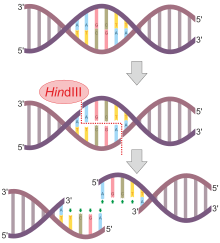
Back نوكلياز Arabic Nukleaza BS Nucleasa Catalan Nukleáza Czech Nukleasen German Nukleaas Estonian نوکلئاز Persian Nucléase French Nuclease Galician נוקלאז HE

In biochemistry, a nuclease (also archaically known as nucleodepolymerase or polynucleotidase) is an enzyme capable of cleaving the phosphodiester bonds that link nucleotides together to form nucleic acids. Nucleases variously affect single and double stranded breaks in their target molecules. In living organisms, they are essential machinery for many aspects of DNA repair. Defects in certain nucleases can cause genetic instability or immunodeficiency.[1] Nucleases are also extensively used in molecular cloning.[2]
There are two primary classifications based on the locus of activity. Exonucleases digest nucleic acids from the ends. Endonucleases act on regions in the middle of target molecules. They are further subcategorized as deoxyribonucleases and ribonucleases. The former acts on DNA, the latter on RNA.[2]
- ^ Nishino T, Morikawa K (December 2002). "Structure and function of nucleases in DNA repair: shape, grip and blade of the DNA scissors". Oncogene. 21 (58): 9022–32. doi:10.1038/sj.onc.1206135. PMID 12483517.
- ^ a b Rittié L, Perbal B (June 2008). "Enzymes used in molecular biology: a useful guide". Journal of Cell Communication and Signaling. 2 (1–2): 25–45. doi:10.1007/s12079-008-0026-2. PMC 2570007. PMID 18766469.